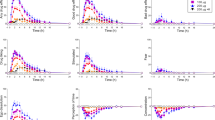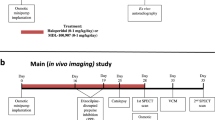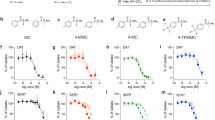Abstract
The 5-HT2A and 5-HT2C antagonists MDL 100,907 and SER-082 were tested with the 5-HT2A/C agonist DOI and the 5-HT1A/2A/2C agonist LSD in the Behavioral Pattern Monitor, which provides multiple measures of locomotor and investigatory activity. Previous investigations have shown that these measures load onto three independent behavioral factors: amount of activity, exploratory behavior, and behavioral organization. Rats pretreated with saline, MDL 100,907 (0.25-2.0 mg/kg), or SER-082 (0.5-1.0 mg/kg) were treated with saline, 0.25 mg/kg DOI, or 60 μg/kg LSD. All effects of DOI were blocked by all doses of MDL 100,907, but only by the highest dose of SER-082. While the effects of LSD on activity and exploratory behavior were largely unaffected, either pretreatment antagonized the effects of LSD on behavioral organization. Thus, all of these effects of DOI were attributable to 5-HT2A receptors, whereas the effect of LSD on behavioral organization was influenced by both 5-HT2A and 5-HT2C receptors.
Similar content being viewed by others
Log in or create a free account to read this content
Gain free access to this article, as well as selected content from this journal and more on nature.com
or
References
Adams LM, Geyer MA . (1982): LSD-induced alterations of locomotor patterns and exploration in rats. Psychopharmacology 77: 179–185
Adams LM, Geyer MA . (1985): A proposed animal model for hallucinogens based on LSD's effects on patterns of exploration in rats. Behav Neurosci 99: 881–900
Carr AA, Hay DD, Dudley MW, Kehne JH, Nieduzak TR . (1991): MDL 28,133A and related α-aryl-4-piperidinyl methanols and ketones as potent and selective inhibitors of serotonin 5-HT2 receptors. Abstracts of the IIIrd International Congress on Schizophrenia Research, Tucson, Arizona.
Geyer MA . (1990): Approaches to the characterization of drug effects on locomotor activity in rodents. In Adler MW, Cowan A (eds), Modern Methods in Pharmacology: Testing and Evaluation of Drugs of Abuse. New York, Wiley-Liss, pp 81–99
Geyer MA, Krebs KM . (1994): Serotonin receptor involvement in an animal model of the acute effects of hallucinogens. In Lin G, Glennon RA (eds), Hallucinogens: An Update. Rockvill, MD, National Institute on Drug Abuse, pp 124–156
Glennon RA, Titeler M, McKenney JD . (1984): Evidence for 5-HT2 involvement in the mechanism of action of hallucinogenic agents. Life Sci 35: 2505–2511
Johnson MP, Siegel BW, Carr AA . (1996): [ 3H]MDL 100,907: A novel selective 5-HT2A receptor ligand. Naunyn-Schmiedeberg's Arch Pharmacol 354: 205–209
Kehne JH, Baron BM, Carr AA, Chaney SF, Elands J, Feldman DJ, Frank RA, van Giersbergen PL, McCloskey TC, Johnson MP, McCarty DR, Poirot M, Senyah Y, Siegel BW, Widmaier C . (1996): Preclinical characterization of the potential of the putative atypical antipsychotic MDL 100,907 as a potent 5-HT2A antagonist with a favorable CNS safety profile. J Pharmacol Exp Ther 277: 968–981
Krebs KM, Geyer MA . (1994): Cross-tolerance studies of serotonin receptors involved in behavioral effects of LSD in rats. Psychopharmacology 113: 429–437
Krebs-Thomson K, Geyer MA . (1996): The role of 5-HT1A receptors in the locomotor-suppressant effects of LSD: WAY-100635 studies of 8-OH-DPAT, DOI, and LSD. Behav Pharmacol 6: 551–559
Mittman SM, Geyer MA . (1991): Dissociation of multiple effects of acute LSD on exploratory behavior in rats by ritanserin and propranolol. Psychopharmacology 105: 69–76
Nozulak J, Kalkman HO, Floersheim P, Hoyer D, Schoeffter P, Buerki HR . (1995): (+)-cis-4,5,7a,8,9,10,11,11a-Octahydro-7H-10methylindol[1,7-bc][2,6]-naphthyridine: A 5HT2C/2B receptor antagonist with low 5-HT2A receptor affinity. J Med Chem 38: 28–33
Padich RA, McCloskey TC, Kehne JH . (1996): 5-HT modulation of auditory and visual sensorimotor gating: II. Effects of the 5-HT2A antagonist MDL 100,907 on disruption of sound and light prepulse inhibition produced by 5-HT agonists in Wistar rats. Psychopharmacology 124: 107–116
Palfreyman MG, Schmidt CJ, Sorenson SM, Dudley MW, Kehne JH, Moser P, Gittos MW, Carr AA . (1993): Electrophysiological, biochemical and behavioral evidence for 5-HT2 and 5-HT3 mediated control of dopaminergic function. Psychopharmacology 112: S60–S67
Paulus MP, Geyer MA . (1993): Three independent factors characterize spontaneous rat motor activity. Behav Brain Res 53: 11–20
Schreiber R, Brocco M, Millan MJ . (1994): Blockade of the discriminative stimulus effects of DOI by MDL 100,907 and the “atypical” antipsychotics, clozapine and risperidone. Eur J Pharmacol 264: 99–102
Sipes TE, Geyer MA . (1995): DOI disruption of prepulse inhibition of startle in the rat is mediated by 5-HT2A and not by 5-HT2C receptors. Behav Pharmacol 6: 839–842
Titeler M, Lyon RA, Glennon RA . (1988): Radioligand binding evidence implicates the brain 5-HT2 receptor as a site of action for LSD and phenylisopropylamine hallucinogens. Psychopharmacology 94: 213–216
Acknowledgements
This work was supported by National Institute on Drug Abuse Award R02 DA02925. M. A. Geyer was supported by a Research Scientist Award from the National Institute of Mental Health (KO5 MH01223).
Author information
Authors and Affiliations
Rights and permissions
About this article
Cite this article
Krebs-Thomson, K., Paulus, M. & Geyer, M. Effects of Hallucinogens on Locomotor and Investigatory Activity and Patterns: Influence of 5-HT2A and 5-HT2C Receptors. Neuropsychopharmacol 18, 339–351 (1998). https://doi.org/10.1016/S0893-133X(97)00164-4
Received:
Revised:
Accepted:
Issue date:
DOI: https://doi.org/10.1016/S0893-133X(97)00164-4
Keywords
This article is cited by
-
Psilocin, LSD, mescaline, and DOB all induce broadband desynchronization of EEG and disconnection in rats with robust translational validity
Translational Psychiatry (2021)
-
Behavioral and neurochemical pharmacology of six psychoactive substituted phenethylamines: mouse locomotion, rat drug discrimination and in vitro receptor and transporter binding and function
Psychopharmacology (2014)
-
Serotonergic hallucinogens differentially modify gamma and high frequency oscillations in the rat nucleus accumbens
Psychopharmacology (2013)
-
Behavioral, neurochemical and pharmaco-EEG profiles of the psychedelic drug 4-bromo-2,5-dimethoxyphenethylamine (2C-B) in rats
Psychopharmacology (2013)
-
Mutual independence of 5-HT2 and α1 noradrenergic receptors in mediating deficits in sensorimotor gating
Psychopharmacology (2012)



